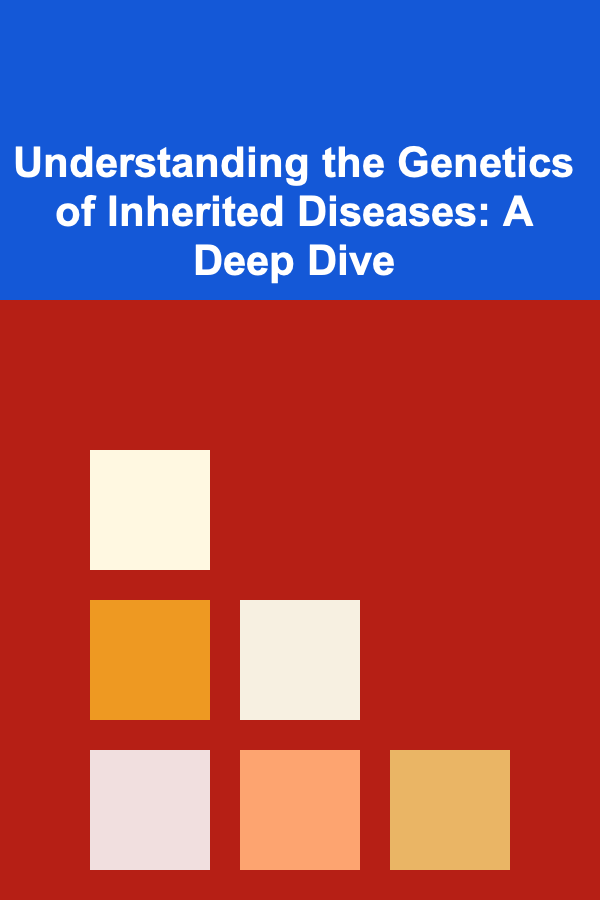
Understanding the Genetics of Inherited Diseases: A Deep Dive
ebook include PDF & Audio bundle (Micro Guide)
$12.99$8.99
Limited Time Offer! Order within the next:

Inherited diseases, also known as genetic disorders, represent a complex and often challenging area of medicine. Understanding their underlying genetic mechanisms is crucial for accurate diagnosis, personalized treatment strategies, and informed reproductive decision-making. This article provides a comprehensive overview of the genetics of inherited diseases, exploring the fundamental principles, different modes of inheritance, the impact of genetic mutations, diagnostic approaches, and the future of genetic medicine in this context.
The Foundation: Genes, Chromosomes, and DNA
At the heart of inherited diseases lies our genetic material: deoxyribonucleic acid (DNA). DNA is a long, double-stranded molecule that contains the instructions for building and maintaining an organism. These instructions are organized into functional units called genes. Each gene codes for a specific protein or RNA molecule, which performs a particular role in the body.
DNA is packaged into structures called chromosomes . Humans have 23 pairs of chromosomes, totaling 46. One member of each pair is inherited from each parent. Of these pairs, 22 are called autosomes and are numbered 1 through 22. The remaining pair are the sex chromosomes , which determine an individual's sex (XX for females and XY for males). The location of a specific gene on a chromosome is called its locus.
The sequence of DNA nucleotides (adenine, guanine, cytosine, and thymine) within a gene determines the amino acid sequence of the protein it encodes. This sequence is vital because even a single change in the DNA sequence can alter the protein's structure and function, potentially leading to disease.
Genetic Mutations: The Root of the Problem
A mutation is a change in the DNA sequence. Mutations can arise spontaneously during DNA replication or be induced by environmental factors such as radiation or exposure to certain chemicals. While some mutations are harmless, others can disrupt gene function and cause inherited diseases.
Mutations can be classified in several ways:
- Point mutations: These involve a change in a single nucleotide.
- Substitutions: One nucleotide is replaced by another (e.g., adenine replaced by guanine). These can be further categorized as transitions (purine to purine or pyrimidine to pyrimidine) or transversions (purine to pyrimidine or vice versa). If a substitution changes the codon to one that codes for a different amino acid, it's called a missense mutation . If the codon is changed to a stop codon, prematurely terminating protein synthesis, it's called a nonsense mutation . A silent mutation is a substitution that doesn't change the amino acid sequence due to the redundancy of the genetic code.
- Insertions: One or more nucleotides are added to the DNA sequence.
- Deletions: One or more nucleotides are removed from the DNA sequence.
- Frameshift mutations: These occur when the insertion or deletion of nucleotides is not a multiple of three (the number of nucleotides in a codon). This shifts the reading frame of the gene, leading to a completely different amino acid sequence downstream of the mutation and often results in a non-functional protein.
- Large-scale mutations: These involve changes in large segments of DNA or entire chromosomes.
- Deletions: Loss of a large segment of a chromosome.
- Duplications: A segment of a chromosome is duplicated, leading to multiple copies of the genes in that region.
- Inversions: A segment of a chromosome is flipped and reinserted.
- Translocations: A segment of a chromosome is moved to another chromosome. These can be reciprocal (exchange of segments between two chromosomes) or Robertsonian (fusion of two acrocentric chromosomes).
- Repeat expansions: Certain regions of DNA contain short sequences that are repeated multiple times. These repeats can expand in size, leading to diseases like Huntington's disease (CAG repeat expansion) and Fragile X syndrome (CGG repeat expansion).
The effect of a mutation depends on several factors, including the location of the mutation within the gene, the type of mutation, and the function of the affected gene. Mutations in critical regions of a gene, such as the active site of an enzyme, are more likely to have severe consequences than mutations in non-coding regions. Some mutations may have no noticeable effect (silent mutations), while others can be lethal.
Modes of Inheritance: Passing Down Genetic Traits
Understanding how genetic traits are passed from parents to offspring is crucial for predicting the risk of inheriting a specific disease. The pattern of inheritance depends on whether the disease-causing gene is located on an autosome or a sex chromosome, and whether the gene is dominant or recessive.
Autosomal Inheritance
Autosomal inheritance refers to the transmission of genes located on the autosomes (chromosomes 1-22). There are two main types of autosomal inheritance:
- Autosomal dominant inheritance: In this pattern, only one copy of the mutated gene is sufficient to cause the disease. If a parent has the disease, there is a 50% chance that each of their children will inherit the mutated gene and develop the disease. Examples of autosomal dominant diseases include Huntington's disease, neurofibromatosis type 1, and Marfan syndrome.
- Autosomal recessive inheritance: In this pattern, two copies of the mutated gene are required for the disease to manifest. Individuals with only one copy of the mutated gene are called carriers. They do not have the disease but can pass the mutated gene to their children. If both parents are carriers, there is a 25% chance that their child will inherit two copies of the mutated gene and develop the disease, a 50% chance that their child will be a carrier, and a 25% chance that their child will inherit two normal copies of the gene and not be affected. Examples of autosomal recessive diseases include cystic fibrosis, sickle cell anemia, and phenylketonuria (PKU).
Sex-linked Inheritance
Sex-linked inheritance refers to the transmission of genes located on the sex chromosomes (X and Y). The most common type of sex-linked inheritance is X-linked inheritance.
- X-linked dominant inheritance: In this pattern, only one copy of the mutated gene on the X chromosome is sufficient to cause the disease. Affected males will pass the condition to all of their daughters but none of their sons. Affected females have a 50% chance of passing the condition to each of their children, regardless of sex. X-linked dominant conditions are relatively rare. An example is hypophosphatemic rickets.
- X-linked recessive inheritance: In this pattern, two copies of the mutated gene on the X chromosome are required for the disease to manifest in females. However, males only have one X chromosome, so one copy of the mutated gene is sufficient to cause the disease. Therefore, X-linked recessive diseases are more common in males than in females. Affected males will pass the mutated gene to all of their daughters, who will become carriers. Carrier females have a 50% chance of passing the mutated gene to each of their sons, who will then be affected. They also have a 50% chance of passing the mutated gene to each of their daughters, who will become carriers. Examples of X-linked recessive diseases include hemophilia and Duchenne muscular dystrophy.
- Y-linked inheritance: Genes on the Y chromosome are only passed from father to son. Therefore, Y-linked traits only affect males. These are relatively rare. An example is male infertility caused by mutations in genes on the Y chromosome.
Mitochondrial Inheritance
Mitochondria are organelles within cells that are responsible for energy production. Mitochondria have their own DNA, which is separate from the DNA in the nucleus. Mitochondrial DNA is inherited exclusively from the mother. Therefore, all children of an affected mother will inherit the mitochondrial mutation and may develop the disease. However, only the mother can pass on the condition, not the father. The severity of mitochondrial diseases can vary greatly, depending on the proportion of mitochondria within a cell that carry the mutation (a phenomenon called heteroplasmy).
Complex Inheritance Patterns
Not all inherited diseases follow simple Mendelian inheritance patterns. Some diseases are caused by a combination of genetic and environmental factors, while others involve multiple genes (polygenic inheritance).
- Multifactorial inheritance: These diseases are caused by a combination of genetic predisposition and environmental factors. Examples include heart disease, diabetes, and some types of cancer. The genetic component may involve multiple genes, each with a small effect. Environmental factors can include diet, lifestyle, and exposure to toxins.
- Polygenic inheritance: These diseases are caused by the combined effects of multiple genes. Each gene contributes a small amount to the overall phenotype. Examples include height, skin color, and intelligence. It can be difficult to identify the specific genes involved in polygenic inheritance, as each gene only has a small effect.
- Epigenetics: Epigenetics refers to changes in gene expression that are not caused by changes in the DNA sequence itself. These changes can be inherited and can affect the risk of developing certain diseases. Epigenetic modifications include DNA methylation and histone modification.
Diagnostic Approaches: Identifying Genetic Disorders
Advances in genetic technology have revolutionized the diagnosis of inherited diseases. A variety of techniques are now available to identify genetic mutations and assess the risk of developing or transmitting a genetic disorder.
- Family history and pedigree analysis: The first step in diagnosing an inherited disease is to take a detailed family history. A pedigree is a diagram that shows the relationships between family members and their medical history. Pedigree analysis can help to determine the mode of inheritance of a disease and to identify individuals who are at risk of developing or transmitting the disease.
- Cytogenetic analysis: This involves examining chromosomes under a microscope. Cytogenetic analysis can detect large-scale chromosomal abnormalities, such as deletions, duplications, and translocations. A common cytogenetic test is karyotyping, which involves arranging chromosomes in order of size and shape.
- Molecular genetic testing: This involves analyzing DNA or RNA to identify specific genetic mutations. There are many different types of molecular genetic tests, including:
- Sanger sequencing: This is a traditional method for sequencing DNA. It is accurate but relatively slow and expensive.
- Next-generation sequencing (NGS): This is a high-throughput sequencing technology that allows for the rapid and cost-effective sequencing of large amounts of DNA. NGS can be used to sequence entire genomes (whole-genome sequencing), specific genes (targeted sequencing), or all the genes in a genome (whole-exome sequencing).
- PCR (polymerase chain reaction): This is a technique used to amplify a specific region of DNA. PCR is often used in conjunction with other genetic tests.
- Microarrays: These are used to detect variations in gene expression or to identify regions of DNA that are deleted or duplicated.
- Southern blotting: This is a technique used to detect specific DNA sequences.
- FISH (fluorescence in situ hybridization): This is a technique used to visualize specific DNA sequences on chromosomes.
- Biochemical testing: This involves measuring the levels of specific proteins or metabolites in blood, urine, or other bodily fluids. Biochemical testing can be used to diagnose certain inherited metabolic disorders.
- Prenatal testing: This involves testing a fetus for genetic disorders before birth. Prenatal testing options include:
- Amniocentesis: This involves taking a sample of amniotic fluid, which surrounds the fetus.
- Chorionic villus sampling (CVS): This involves taking a sample of placental tissue.
- Non-invasive prenatal testing (NIPT): This involves analyzing fetal DNA that is circulating in the mother's blood. NIPT is a relatively new technology that is becoming increasingly popular.
- Preimplantation genetic diagnosis (PGD): This involves testing embryos created through in vitro fertilization (IVF) for genetic disorders before they are implanted in the uterus.
Genetic Counseling: Providing Support and Guidance
Genetic counseling is an essential part of the management of inherited diseases. Genetic counselors are healthcare professionals who provide information and support to individuals and families who are affected by or at risk of inheriting a genetic disorder. Genetic counselors can help individuals and families:
- Understand the inheritance pattern of a genetic disorder.
- Assess their risk of developing or transmitting a genetic disorder.
- Make informed decisions about genetic testing.
- Cope with the emotional and psychological impact of a genetic disorder.
- Identify resources and support groups.
Treatment Strategies: Managing Inherited Diseases
While there is no cure for many inherited diseases, there are treatments available to manage the symptoms and improve the quality of life for affected individuals. Treatment strategies vary depending on the specific disease and can include:
- Medications: Medications can be used to treat the symptoms of inherited diseases or to replace missing proteins or enzymes.
- Dietary modifications: Dietary modifications can be used to manage certain inherited metabolic disorders, such as phenylketonuria (PKU).
- Surgery: Surgery may be necessary to correct certain birth defects or to manage complications of inherited diseases.
- Gene therapy: Gene therapy involves introducing a normal copy of a gene into the cells of an individual with a genetic disorder. Gene therapy is a promising treatment approach for some inherited diseases, but it is still in the early stages of development.
- Enzyme replacement therapy: This therapy is used for lysosomal storage diseases, where a defective enzyme leads to the accumulation of specific substances in cells. ERT involves infusing the missing or deficient enzyme into the patient.
- Stem cell transplantation: In some cases, stem cell transplantation can be used to replace damaged cells with healthy cells. This is used, for example, in some cases of sickle cell anemia and thalassemia.
The Future of Genetic Medicine: Towards Personalized Therapies
The field of genetic medicine is rapidly evolving, driven by advances in technology and a deeper understanding of the human genome. The future of genetic medicine holds great promise for the diagnosis, treatment, and prevention of inherited diseases.
- Personalized medicine: Personalized medicine involves tailoring medical treatment to the individual characteristics of each patient, including their genetic makeup. Genetic testing can be used to identify individuals who are at risk of developing certain diseases or who are likely to respond to specific treatments.
- Gene editing: Gene editing technologies, such as CRISPR-Cas9, allow scientists to precisely edit DNA sequences. Gene editing has the potential to cure inherited diseases by correcting the underlying genetic mutation.
- Improved diagnostic tools: New and improved diagnostic tools are being developed to identify genetic disorders earlier and more accurately. These tools will allow for earlier intervention and improved outcomes.
- Drug development: A better understanding of the genetic basis of inherited diseases is leading to the development of new drugs that target the underlying disease mechanisms.
- Preventive strategies: Genetic testing and counseling can be used to identify individuals who are at risk of transmitting a genetic disorder to their children. This information can be used to make informed reproductive decisions and to prevent the birth of affected children. Preconception carrier screening is becoming increasingly common.
Ethical Considerations
The advances in genetic technology also raise important ethical considerations. These include:
- Privacy: Genetic information is highly personal and sensitive. It is important to protect the privacy of individuals and families who undergo genetic testing.
- Discrimination: Genetic information could be used to discriminate against individuals in employment, insurance, or other areas. Laws are in place in many countries to prevent genetic discrimination.
- Informed consent: It is important to ensure that individuals understand the risks and benefits of genetic testing before they undergo testing.
- Access to genetic testing: Genetic testing can be expensive and may not be accessible to everyone. Efforts are needed to ensure that genetic testing is available to all who need it.
- Eugenics: The potential for misuse of genetic information to promote eugenics (the improvement of the human race through selective breeding) is a serious concern. Careful consideration must be given to the ethical implications of all genetic technologies.
Conclusion
Understanding the genetics of inherited diseases is a complex but essential endeavor. By understanding the underlying genetic mechanisms, modes of inheritance, and available diagnostic and treatment options, we can improve the lives of individuals and families affected by these disorders. The future of genetic medicine holds great promise for the development of personalized therapies and preventive strategies that will further reduce the burden of inherited diseases. However, it is crucial to address the ethical considerations associated with these advances to ensure that genetic technologies are used responsibly and equitably.
Reading More From Our Other Websites
- [Home Budget Decorating 101] How to Decorate Small Spaces on a Budget
- [Needle Felting Tip 101] Creative Variations: From Cute Kittens to Stylized Cat Characters in Needle Felting
- [Home Cleaning 101] How to Create an Allergy-Friendly Space: Essential Cleaning for Allergy Sufferers Tips
- [Home Pet Care 101] How to Maintain a Healthy Grooming Routine for Your Pet
- [Organization Tip 101] How to Use Shelving Units for Efficient Family Room Storage
- [Home Security 101] How to Use Lighting to Deter Intruders
- [Organization Tip 101] How to Keep Track of Loaned Sports Equipment
- [Organization Tip 101] How to Use Multi-Functional Furniture to Save Space
- [Organization Tip 101] How to Store Books Creatively in a Small Room
- [Home Lighting 101] How to Choose the Best Table Lamps for Your Home Office or Living Room

How to Handle Property Damage Caused by Tenants
Read More
How to Protect Your Appliances from Power Surges
Read More
Leveraging Social Media in Your Job Search: Strategies for Success
Read More
How to Understand the Genetics of Diabetes
Read More
How to Build a Starter Emergency Fund on a Tight Budget
Read More
How to Hand Letter Vintage Movie Titles
Read MoreOther Products

How to Handle Property Damage Caused by Tenants
Read More
How to Protect Your Appliances from Power Surges
Read More
Leveraging Social Media in Your Job Search: Strategies for Success
Read More
How to Understand the Genetics of Diabetes
Read More
How to Build a Starter Emergency Fund on a Tight Budget
Read More